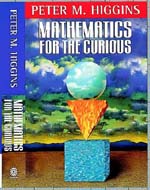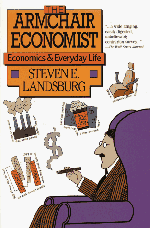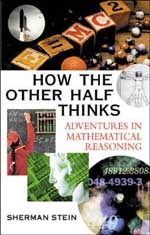book review
This charming book is in its second edition (the first was published in 1994). It is about integers, with a short section for each number between 1 and 200, and a line for each between 201 and 999. There are "boxes" for interesting facts and definitions, such as "perfect number", and a few "large numbers" also make the cut, including 1729, the subject of a famous anecdote about Hardy and Ramanujan, and 101000, the googol.
Infinity is more than simply the biggest ever number, and even this simple description has caused problems for mathematicians throughout the ages. From the ancient Greeks to Newton, from Newton to present-day mathematicians such as Cristian Claude and Boris Pavlov of New Zealand, infinity has posed both practical and conceptual problems.
It feels like we've always known that the universe began with a Big Bang, and like the Big Bang could never have been called anything else. But this is far from the truth, as Simon Singh explains in this overview of the state of human knowledge about the beginning of everything (or, as Calvin of "Calvin and Hobbes" preferred to call it, the Great Kablooie).
Most of us could not work without a computer, or have a good time without a CD player, and yet we know very little about the way computers work or the quantum mechanical principles behind lasers. These two subjects involve complex concepts and it is not easy to explain them in a brief book. Nevertheless, "A shortcut through time" manages to present a clear and enjoyable crash course on quantum computers, a science which lies at the intersection between quantum mechanics, computer science and mathematics.
Have you ever wondered how high a flea of the size of a human could jump, why rivers meander or how high a tree can grow? Mathematics in Nature provides answers to all these questions and many more, while introducing the reader to the ideas and methods of mathematical modelling.
This book from Professor Sir Michael Marmot (knighted for his services to epidemiology and understanding health inequalities) is concerned with a very simple question: why do people of higher status have better health and live longer than those of lower status?
After years of publications on popular science and mathematics, we all know that mathematics can provide answers to questions arising from everyday life. If we want to find out when the two hands of a clock will be in exactly the same position or to calculate the volume of a doughnut, we will certainly need to use some maths. But how difficult can this be?
I have never before read a book that has so frequently made me think "wow, that's interesting!". "Mathematics for the Imagination" is an absolutely fascinating account of mathematical methods and discoveries and the people behind them, with the sordid histories of mathematicians through the ages jostling for the reader's attention next to their elegantly simple proofs.
"Economic theory predicts that you are not enjoying this book as much as you thought you would", remarks Steven E. Landsburg at the start of one of the most enjoyable chapters of The Armchair Economist. The point turns out to be this: the fact that you have chosen to read it is a sign that you have probably overvalued it in relation to all the other books you could have read instead.
Although this book is 50 years old this year, its wisdom is needed now more than ever, as increasing computer power and our headline-obsessed media look set to drown us all in a sea of "statisticulation". This is the word coined by Darrell Huff to describe misinformation by the use of statistical material. Biased samples, dubious graphs, semi-attached figures: he describes all the usual suspects clearly and simply, rounding off with the most useful topic of all: How to Talk Back to a Statistic.
We live in a world that obeys many physical laws, and that can be modelled by a variety of mathematics. It is surprising what a variety of problems can be described by very similar models. Robert B. Banks does not concentrate on the most common examples of applied mathematics, but instead covers a fascinating selection of topics as varied as the US national debt, the Eiffel Tower, and the flight of golf balls.
Most people think that mathematics consists of either just arithmetic, or a collection of very abstract and technical topics which the layperson has no chance of grasping. But this really is not true: of course many areas are too technical for the non-mathematician, but there are also many beautiful and non-trivial facts which can be expressed in ordinary language for everyone to appreciate.











